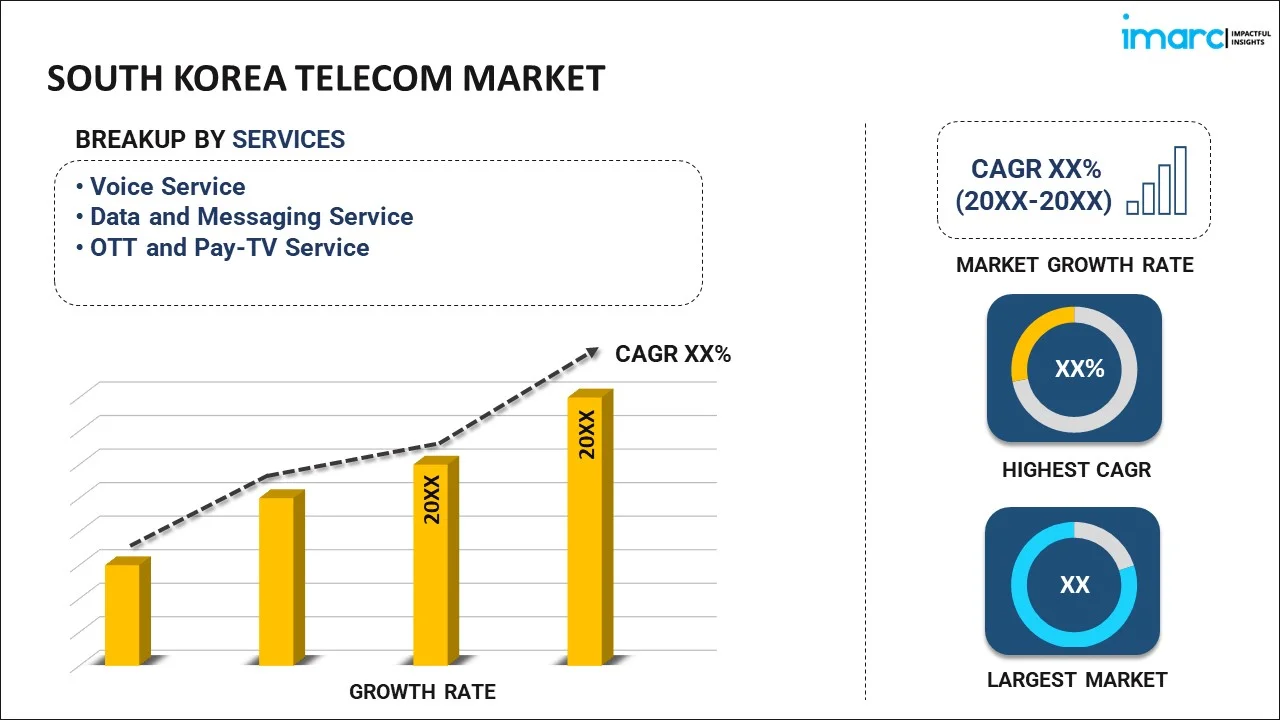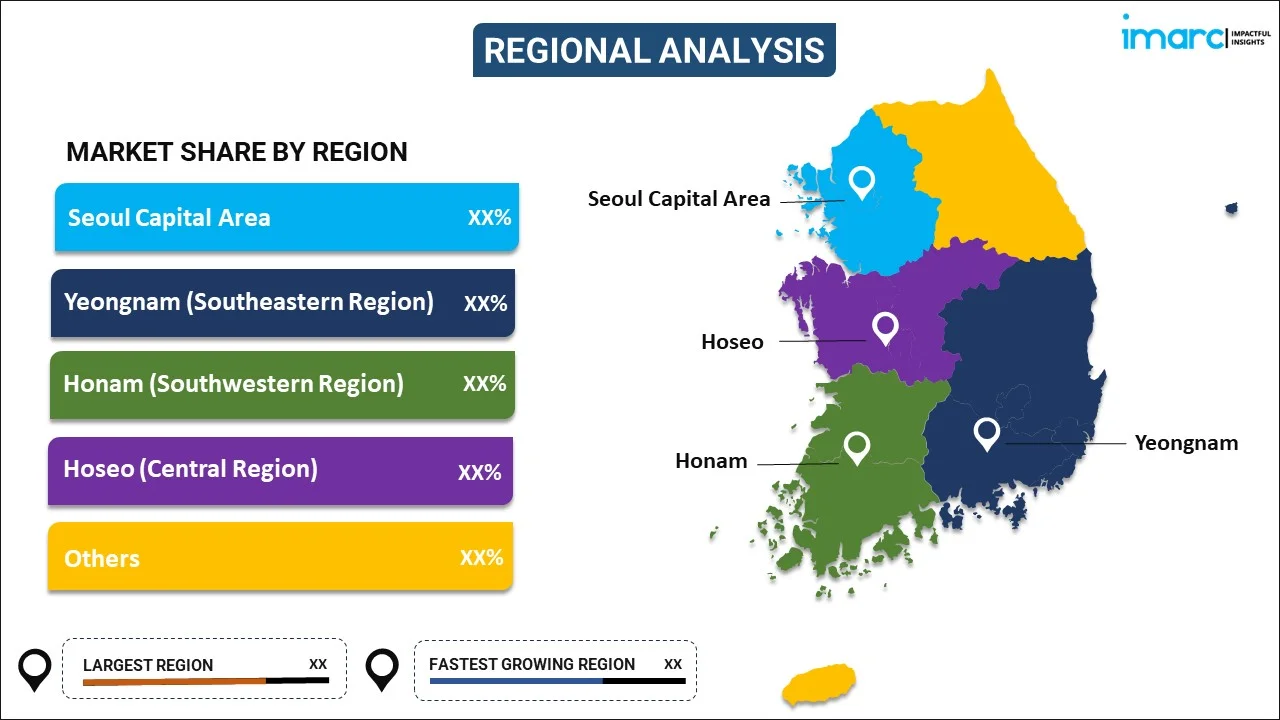
South Korea Telecom Market Report by Service (Voice Service, Data and Messaging Service, OTT and Pay-TV Service), and Region 2025-2033
Market Overview:
South Korea telecom market size reached USD 40.0 Billion in 2024. Looking forward, IMARC Group expects the market to reach USD 50.0 Billion by 2033, exhibiting a growth rate (CAGR) of 4.3% during 2025-2033. The rapid digitalization, rising emphasis on automation and cloud computing across different industry verticals, and the increasing need for data-intensive services, such as streaming, online gaming, and the Internet of Things (IoT) applications represent some of the key factors driving the market.
|
Report Attribute
|
Key Statistics
|
|---|---|
|
Base Year
|
2024 |
|
Forecast Years
|
2025-2033
|
|
Historical Years
|
2019-2024
|
| Market Size in 2024 | USD 40.0 Billion |
| Market Forecast in 2033 | USD 50.0 Billion |
| Market Growth Rate (2025-2033) | 4.3% |
Telecom is the science and technology of transmitting information over long distances. It generally uses digital signals, which offer clarity and reliability in the swift exchange of text, voice, and multimedia content. It has security measures like encryption and authentication that protect sensitive information during transmission. It enables real-time communication across vast distances, facilitating efficient exchange of information. It reduces the cost of communication compared to traditional methods like postal services and physical meetings. It is widely used by businesses for conducting virtual seminars, interviews, and webinars. Besides this, as it connects people and businesses and supports international collaboration and trade, the demand for telecom is increasing across South Korea.
South Korea Telecom Market Trends:
The expansion of telecom companies to meet the connectivity needs of people represent one of the key factors stimulating the market growth in South Korea. Additionally, the rising emphasis on automation and cloud computing across various industries are strengthening the growth of the market. Along with this, the increasing use of data-intensive services, such as streaming, online gaming, and the Internet of Things (IoT) applications, is resulting in expanding data usage, which is influencing the market positively in the country. Telecom providers are expanding their network capabilities to meet this demand. Apart from this, the rising adoption of remote work modules is driving the demand for efficient telecom to facilitate employees in connecting to their workplaces from anywhere. Furthermore, the increasing construction of smart cities is offering a favorable market outlook. Telecommunications facilitate the connection of IoT devices, enabling smart homes, cities, and industries. Moreover, the widespread deployment of fifth generation (5G) networks, coupled with ongoing research and development (R&D), is supporting cutting-edge telecom technologies in South Korea. Besides this, governing authorities of the country are undertaking numerous initiatives to reduce regulatory barriers, promote investment in infrastructure, encourage competition, and create a conducive environment for telecom companies. Along with this, they are promoting e-government services to streamline administrative processes and improve citizen services. This includes online tax filing, e-healthcare, and digital education, which drives the demand for telecom networks to deliver these services securely and efficiently. Besides this, various telecom providers in South Korea are diversifying their offerings by integrating services like video streaming, cloud storage, and e-commerce into their portfolios, creating one-stop solutions for individuals. They are also focusing on reducing their carbon footprint by using renewable energy sources and implementing energy-efficient technologies to promote environmental health.
South Korea Telecom Market Segmentation:
IMARC Group provides an analysis of the key trends in each segment of the market, along with forecasts at the country level for 2025-2033. Our report has categorized the market based on service.
Service Insights:

- Voice Service
- Wired
- Wireless
- Data and Messaging Service
- OTT and Pay-TV Service
The report has provided a detailed breakup and analysis of the market based on the service. This includes voice service (wired and wireless), data and messaging service, and OTT and pay-TV service.
Regional Insights:

- Seoul Capital Area
- Yeongnam (Southeastern Region)
- Honam (Southwestern Region)
- Hoseo (Central Region)
- Others
The report has also provided a comprehensive analysis of all the major regional markets, which include Seoul Capital Area, Yeongnam (Southeastern Region), Honam (Southwestern Region), Hoseo (Central Region), and others.
Competitive Landscape:
The market research report has also provided a comprehensive analysis of the competitive landscape in the market. Competitive analysis such as market structure, key player positioning, top winning strategies, competitive dashboard, and company evaluation quadrant has been covered in the report. Also, detailed profiles of all major companies have been provided.
South Korea Telecom Market Report Coverage:
| Report Features | Details |
|---|---|
| Base Year of the Analysis | 2024 |
| Historical Period | 2019-2024 |
| Forecast Period | 2025-2033 |
| Units | Billion USD |
| Scope of the Report | Exploration of Historical Trends and Market Outlook, Industry Catalysts and Challenges, Segment-Wise Historical and Future Market Assessment:
|
| Services Covered |
|
| Regions Covered | Seoul Capital Area, Yeongnam (Southeastern Region), Honam (Southwestern Region), Hoseo (Central Region), Others |
| Customization Scope | 10% Free Customization |
| Post-Sale Analyst Support | 10-12 Weeks |
| Delivery Format | PDF and Excel through Email (We can also provide the editable version of the report in PPT/Word format on special request) |
Key Questions Answered in This Report:
- How has the South Korea telecom market performed so far and how will it perform in the coming years?
- What has been the impact of COVID-19 on the South Korea telecom market?
- What is the breakup of the South Korea telecom market on the basis of service?
- What are the various stages in the value chain of the South Korea telecom market?
- What are the key driving factors and challenges in the South Korea telecom?
- What is the structure of the South Korea telecom market and who are the key players?
- What is the degree of competition in the South Korea telecom market?
Key Benefits for Stakeholders:
- IMARC’s industry report offers a comprehensive quantitative analysis of various market segments, historical and current market trends, market forecasts, and dynamics of the South Korea telecom market from 2019-2033.
- The research report provides the latest information on the market drivers, challenges, and opportunities in the South Korea telecom market.
- Porter's five forces analysis assist stakeholders in assessing the impact of new entrants, competitive rivalry, supplier power, buyer power, and the threat of substitution. It helps stakeholders to analyze the level of competition within the South Korea telecom industry and its attractiveness.
- Competitive landscape allows stakeholders to understand their competitive environment and provides an insight into the current positions of key players in the market.
Need more help?
- Speak to our experienced analysts for insights on the current market scenarios.
- Include additional segments and countries to customize the report as per your requirement.
- Gain an unparalleled competitive advantage in your domain by understanding how to utilize the report and positively impacting your operations and revenue.
- For further assistance, please connect with our analysts.
 Inquire Before Buying
Inquire Before Buying
 Speak to an Analyst
Speak to an Analyst
 Request Brochure
Request Brochure
 Request Customization
Request Customization




.webp)




.webp)












